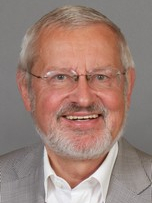Prof. Dr. Ulf Eysel, Neurophysiology, Faculty of Medicine

Research Programme:
Plasticity in the mature visual system
The visual system is the central scientific field of research in our department, and intracortical processing as well as neuronal plasticity following localized lesions are among my main interests.
In our investigations we combine electrophysiological, neuroanatomical, molecular biological and imaging techniques. Within the IGSN my laboratory cooperates with all laboratories of the Department of Neurophysiology, with the Department of Neuroanatomy and Molecular Brain Research, with the Institute for Neural Computation and the Neurological University Clinics.
My longstanding aim is the understanding of cortical contributions to the functional specificities of cells in the visual cortex and the characterization of mechanisms of lesion induced plasticity in the visual system. My experimental models are small localized chemical and laser lesions or localized activation as well as inactivation at different levels of the afferent visual system. The PhD thesis proposal described below is embedded in one of our current main research fields, the investigation of the spatio-temporal dynamics of plasticity following cortical and retinal lesions.
PhD-projects
The effects of retinal and cortical lesions on functional plasticity in the adult visual system - investigation of possible effects on monocular deprivation (MD)
Recently we have discovered that after cortical and after retinal lesions similar patterns of increased cortical plasticity are observed in adult rats and cats. In a certain region at the border of a cortical lesion and at the border of the cortical lesion projection zone (cLPZ) inhibition is relatively reduced and excitation strongly increased leading to hyperexcitability and a significantly stronger long-term potentiation (LTP). This is accompanied by increased stimulus induced calcium transients and characteristic molecular biological changes of NMDA receptor subunit composition and aCaMKII phosphorylation. Our hypothesis is that lesions in the afferent visual system introduce a degree of synaptic plasticity in parts of the adult visual cortex that might be comparable to the plasticity seen in this whole brain region during early postnatal development.
On the other hand, it is well known that in a postnatal critical period certain properties of visual cortical cells can be modified by use or disuse. One classical example is the shift of the ocular dominance from the monocularly deprived eye to the normal eye during monocular deprivation (MD) in early postnatal life, an effect that cannot be elicited any more in adulthood. If our hypothesis is correct, ocular dominance shifts should again occur during MD in adulthood, however, restricted to the regions of lesion induced hyperexcitability and plasticity.
To test this hypothesis we will induce infrared-laser lesions in the eye or in the visual cortex of adult cats and rodents. This will be followed by a period of monocular deprivation. Thereafter the ocular dominance distribution will be studied in single cells and in the two-dimensional cortical ocular dominance maps of the visual cortex using multimicroelectrode array recordings an optical imaging of intrinsic signals. These experiments are important to prove the systemic relevance of the enhanced cortical plasticity following lesions in the visual system, which in turn is a necessary prerequisite to judge its possible relevance for use dependent rehabilitation.


